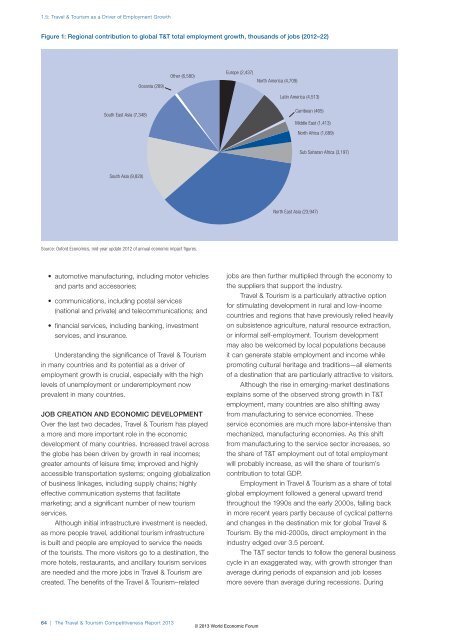The Travel & Tourism Competitiveness Report 2013
The Travel & Tourism Competitiveness Report 2013
The Travel & Tourism Competitiveness Report 2013
Create successful ePaper yourself
Turn your PDF publications into a flip-book with our unique Google optimized e-Paper software.
1.5: <strong>Travel</strong> & <strong>Tourism</strong> as a Driver of Employment Growth<br />
Figure 1: Regional contribution to global T&T total employment growth, thousands of jobs (2012–22)<br />
South East Asia (7,348)<br />
South Asia (9,820)<br />
Oceania (289)<br />
Source: Oxford Economics, mid-year update 2012 of annual economic impact figures.<br />
• automotive manufacturing, including motor vehicles<br />
and parts and accessories;<br />
• communications, including postal services<br />
(national and private) and telecommunications; and<br />
• financial services, including banking, investment<br />
services, and insurance.<br />
Understanding the significance of <strong>Travel</strong> & <strong>Tourism</strong><br />
in many countries and its potential as a driver of<br />
employment growth is crucial, especially with the high<br />
levels of unemployment or underemployment now<br />
prevalent in many countries.<br />
JOB CREATION AND ECONOMIC DEVELOPMENT<br />
Over the last two decades, <strong>Travel</strong> & <strong>Tourism</strong> has played<br />
a more and more important role in the economic<br />
development of many countries. Increased travel across<br />
the globe has been driven by growth in real incomes;<br />
greater amounts of leisure time; improved and highly<br />
accessible transportation systems; ongoing globalization<br />
of business linkages, including supply chains; highly<br />
effective communication systems that facilitate<br />
marketing; and a significant number of new tourism<br />
services.<br />
Although initial infrastructure investment is needed,<br />
as more people travel, additional tourism infrastructure<br />
is built and people are employed to service the needs<br />
of the tourists. <strong>The</strong> more visitors go to a destination, the<br />
more hotels, restaurants, and ancillary tourism services<br />
are needed and the more jobs in <strong>Travel</strong> & <strong>Tourism</strong> are<br />
created. <strong>The</strong> benefits of the <strong>Travel</strong> & <strong>Tourism</strong>–related<br />
64 | <strong>The</strong> <strong>Travel</strong> & <strong>Tourism</strong> <strong>Competitiveness</strong> <strong>Report</strong> <strong>2013</strong><br />
Other (6,580)<br />
Europe (2,437)<br />
North America (4,709)<br />
Latin America (4,513)<br />
Carribean (465)<br />
Middle East (1,413)<br />
North Africa (1,689)<br />
North East Asia (23,947)<br />
Sub Saharan Africa (3,197)<br />
jobs are then further multiplied through the economy to<br />
the suppliers that support the industry.<br />
<strong>Travel</strong> & <strong>Tourism</strong> is a particularly attractive option<br />
for stimulating development in rural and low-income<br />
countries and regions that have previously relied heavily<br />
on subsistence agriculture, natural resource extraction,<br />
or informal self-employment. <strong>Tourism</strong> development<br />
may also be welcomed by local populations because<br />
it can generate stable employment and income while<br />
promoting cultural heritage and traditions—all elements<br />
of a destination that are particularly attractive to visitors.<br />
Although the rise in emerging-market destinations<br />
explains some of the observed strong growth in T&T<br />
employment, many countries are also shifting away<br />
from manufacturing to service economies. <strong>The</strong>se<br />
service economies are much more labor-intensive than<br />
mechanized, manufacturing economies. As this shift<br />
from manufacturing to the service sector increases, so<br />
the share of T&T employment out of total employment<br />
will probably increase, as will the share of tourism’s<br />
contribution to total GDP.<br />
Employment in <strong>Travel</strong> & <strong>Tourism</strong> as a share of total<br />
global employment followed a general upward trend<br />
throughout the 1990s and the early 2000s, falling back<br />
in more recent years partly because of cyclical patterns<br />
and changes in the destination mix for global <strong>Travel</strong> &<br />
<strong>Tourism</strong>. By the mid-2000s, direct employment in the<br />
industry edged over 3.5 percent.<br />
<strong>The</strong> T&T sector tends to follow the general business<br />
cycle in an exaggerated way, with growth stronger than<br />
average during periods of expansion and job losses<br />
more severe than average during recessions. During<br />
© <strong>2013</strong> World Economic Forum

















